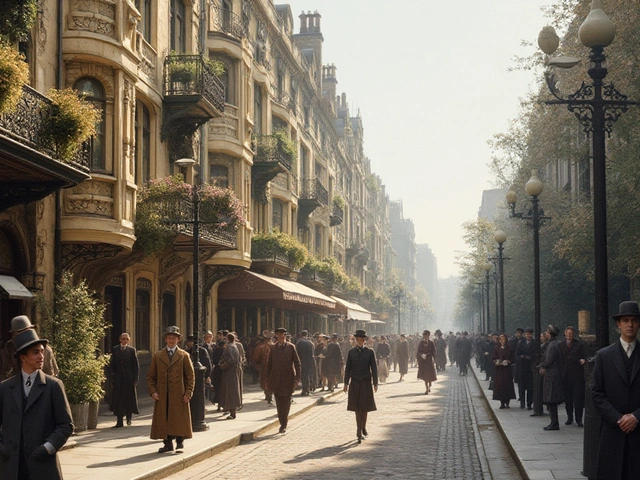Kinetic Art Balance Calculator
Simulate Torque Balance
Calculate how weight distribution affects motion in kinetic sculptures. Based on physics principles described in the article.
Balance Result
When you walk past a piece of art and it moves - not because someone touched it, but because the wind caught it, or a motor hummed quietly inside - you don’t just see it. You feel it. That’s kinetic art. It doesn’t sit still. It breathes. It sways. It spins. And it’s not just decoration. It’s science made visible, engineering turned poetic.
What Exactly Is Kinetic Art?
Kinetic art is any artwork that contains movement as a core part of its design. This isn’t about animation on a screen. It’s physical motion - real metal, glass, plastic, or fabric shifting in space. The movement can be powered by wind, water, motors, magnets, or even the viewer’s own steps. Some pieces rotate slowly. Others flicker like a heartbeat. A few respond to touch or sound.
The term became popular in the 1950s, but the idea is older. Ancient Greek water clocks had moving figures. Medieval wind chimes rang out with rhythm. But modern kinetic art truly took off after World War II, when artists started working with engineers and physicists. Names like Alexander Calder, George Rickey, and Jean Tinguely became famous not just for beauty, but for how their pieces danced.
Calder’s mobiles - those delicate, hanging sculptures with balanced shapes - were among the first to prove that art didn’t need to be static to be profound. A single piece could change its form every time the air moved. No two viewings were ever the same.
The Science Behind the Motion
Kinetic art isn’t magic. It’s physics. Every spinning arm, every swinging rod, every oscillating panel follows the laws of balance, gravity, friction, and momentum. Artists don’t guess how something will move - they calculate it.
Take a wind-driven sculpture. To make it spin smoothly without wobbling, the artist must balance weight distribution down to the gram. Too heavy on one side? It’ll jerk. Too light? It won’t respond to a breeze. Engineers call this moment of inertia. Artists call it intuition - built on years of trial and error.
Some artists use motors to control speed and rhythm. In the 1960s, Japanese artist Toshiyuki Kita built motorized sculptures that moved in precise, repetitive patterns, mimicking biological rhythms. His work wasn’t just about motion - it was about time. Each rotation was a second, a minute, a heartbeat made visible.
Even the materials matter. Aluminum is light and won’t rust. Brass has a slow, rich swing. Carbon fiber lets artists create thin, strong arms that move with almost no resistance. One artist in Melbourne, working out of a garage in Collingwood, uses recycled bicycle parts to build wind sculptures that chime like wind bells - each component chosen for its sound as much as its motion.
When Art Becomes a System
The most powerful kinetic pieces aren’t just moving objects - they’re systems. They respond to their environment. They interact. They adapt.
One famous example is Kinetic Rain a large-scale installation at Singapore’s Changi Airport, made of 1,200 copper-coated aluminum droplets suspended from wires, moving in synchronized patterns to mimic falling rain. It doesn’t just fall - it dances. It slows when the airport is quiet. It quickens during rush hour. Sensors track foot traffic, and the motion changes accordingly.
That’s not just art. That’s responsive design. That’s science meeting emotion.
Another example: Wind Harp a public installation in Melbourne’s Docklands, made of 36 vertical steel rods that vibrate in the southern winds, producing low, resonant tones. It doesn’t need electricity. It doesn’t need a button. It sings when the wind does. People stop to listen. Some sit for hours. It’s art that doesn’t demand attention - it earns it.

Why Kinetic Art Feels Different
Why does a spinning sculpture pull you in more than a painted canvas? Because your brain is wired to notice motion. It’s evolutionary. In nature, movement means life - prey, predator, danger, opportunity. Our eyes lock onto it before our minds catch up.
Kinetic art hijacks that instinct. It doesn’t just sit there waiting to be admired. It performs. It changes. It surprises. You don’t just look at it - you wait for the next twist, the next swing, the next flash of light reflecting off a turning surface.
Studies in cognitive psychology show that viewers spend 37% longer with kinetic art than with static pieces. The movement creates anticipation. It builds narrative. Even if the motion is random, your brain tries to find a pattern. That’s why people return to the same piece again and again. They’re not just looking. They’re listening. Waiting. Wondering.
Where to Find Kinetic Art Today
You don’t need to fly to New York or Tokyo to see it. Cities around the world have embraced kinetic art as public installations. In Melbourne, you can find rotating wind sculptures at Federation Square, motion-responsive light panels along the Yarra River, and even a kinetic fountain in the Royal Botanic Gardens that shifts its spray based on real-time weather data.
Museums have dedicated sections too. The Museum of Modern Art in New York has a whole wing for Calder’s mobiles. The Tate Modern in London displays works by Anthony Howe, whose intricate, turbine-like sculptures look like mechanical jellyfish caught in a storm. In Berlin, the ZKM Center for Art and Media runs a permanent exhibit on kinetic and electronic art.
And it’s not just for galleries. Architects now integrate kinetic elements into buildings - facades that open with the sun, canopies that ripple in the wind, staircases that glow as people climb. Kinetic art is no longer a niche. It’s becoming part of how we design spaces.

What Makes a Great Kinetic Piece?
Not every spinning thing is art. A ceiling fan moves. A car wheel spins. What’s the difference?
Great kinetic art has intention. It has rhythm. It has emotion.
Here’s what separates the good from the great:
- Controlled unpredictability - The motion feels organic, not robotic. It’s precise, but never mechanical.
- Material harmony - The metal, glass, or fabric doesn’t just move - it sings. It reflects light, catches shadows, makes sound.
- Context - It fits its space. A sculpture in a park responds to wind and rain. One in a museum might react to light or sound.
- Emotional impact - Does it make you pause? Smile? Feel calm? Or uneasy? If it doesn’t stir something, it’s just a machine.
One artist in Perth, working with solar-powered motors, built a series of abstract shapes that open at sunrise and close at sunset. No buttons. No app. Just light. People call it their ‘daily ritual.’ That’s the power of kinetic art - it turns time into something you can see.
The Future of Moving Art
The next wave of kinetic art is blending with smart technology. Artists are using AI to generate motion patterns based on real-time data - air quality, temperature, even social media sentiment. One project in London used Twitter trends to control the speed of a rotating sculpture. When people tweeted about joy, it spun faster. When the tone turned dark, it slowed to a crawl.
3D printing is letting artists create complex internal mechanisms that were once impossible to machine. Tiny gears, interlocking arms, invisible pivots - all printed in one piece. No screws. No assembly. Just motion, born from code and filament.
And then there’s sustainability. More artists are using recycled materials - old clock parts, broken electronics, discarded bicycle chains. One Melbourne-based collective turned 800 plastic bottles into a wind-responsive installation that looks like a school of fish swimming through the air. It’s art that moves, yes - but also speaks.
Kinetic art isn’t dying. It’s evolving. It’s no longer just about how something moves. It’s about why it moves. What it responds to. What it makes us feel.
At its best, kinetic art doesn’t just hang on a wall. It becomes part of the air around you. A whisper of motion. A silent song. A moment you didn’t know you were waiting for.
Is kinetic art the same as sculpture?
All kinetic art is sculpture, but not all sculpture is kinetic. Traditional sculpture is static - carved, cast, or assembled to remain unchanged. Kinetic art is sculpture designed to move. The movement isn’t an add-on; it’s the point. Think of it as sculpture with a heartbeat.
Do you need electricity for kinetic art?
No. Many kinetic pieces use natural forces - wind, water, sunlight, or even the viewer’s movement. Alexander Calder’s mobiles rely only on air currents. Wind harps use the breeze. Some use magnets or gravity. Electricity is just one tool, not a requirement. In fact, the most elegant pieces often avoid it entirely.
Can I make kinetic art at home?
Absolutely. Start simple. Hang a few metal shapes from fishing line and let the wind move them. Use old spoons, bottle caps, or wire hangers. Balance them so they swing slowly. Add a small bell or chime for sound. You don’t need fancy tools - just curiosity. Many artists begin with wind-driven pieces because they’re low-cost and deeply responsive to their environment.
Why do some kinetic sculptures make noise?
Sound turns movement into experience. A spinning blade slicing through air, a metal rod tapping gently against another - these sounds anchor the motion in your senses. Artists like Harry Bertoia used metal rods to create musical sculptures. The noise isn’t accidental; it’s composed. The rhythm of the sound becomes part of the art’s language.
Is kinetic art expensive to maintain?
It depends. Wind-powered pieces need almost no maintenance - just occasional cleaning. Motorized ones require lubrication, motor checks, and sometimes part replacements. Outdoor pieces must resist rust and weather. But many artists design for durability - using marine-grade stainless steel, UV-resistant coatings, or sealed bearings. A well-built kinetic sculpture can last decades with minimal care.




